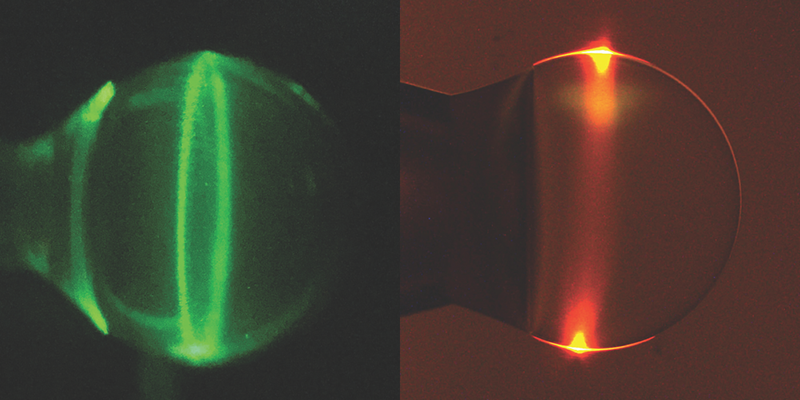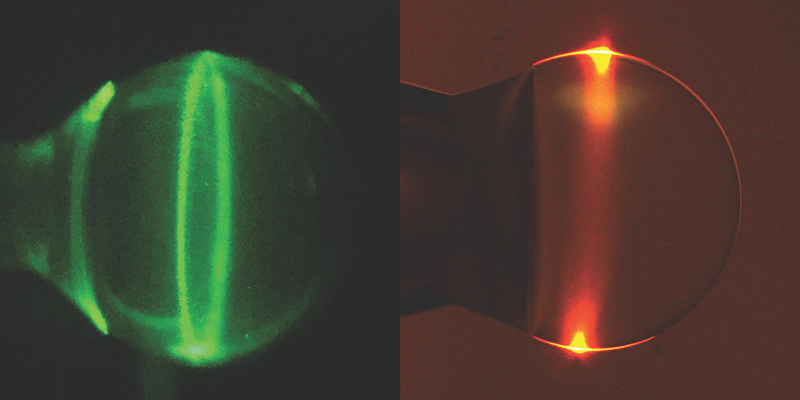A Soap Bubble Becomes a Laser
Soap bubbles are known for their attention-grabbing effect on toddlers, and now researchers have shown that these objects have another dazzling use—generating color-tunable laser light [1]. They demonstrated that a dye dissolved in the soap solution of such a bubble can amplify light circulating in the spherical shell and produce laser light. This light is visible as a glowing ring around the bubble. Such “bubble lasers” could act as precision sensors for measuring atmospheric pressure or for detecting changes in an electric field.
The allure of bubbles comes in large part from their interaction with light. As soap bubbles dance through the air, they sparkle like glitter, shifting hues as they move. This phenomenon, known as iridescence, comes from the interference of light waves within a bubble’s soapy shell.
Researchers have also shown that laser light can propagate within a bubble’s shell, branching out into filamentous structures that resemble lightning [2]. The light in each of the thousands of glowing filaments that can develop stays focused. These observations led Matjaž Humar and Zala Korenjak of the Jožef Stefan Institute and the University of Ljubljana, both in Slovenia, to ask if a bubble could be used to create laser light. Other kinds of spherical shells have been used as laser cavities, Humar says, so “I wondered if the bubble might work in that way.”
To test the idea, Humar and Korenjak created a device using a standard soap bubble solution mixed with a fluorescent dye. The bubble was held on the end of a capillary tube and illuminated with a pulsed laser. The researchers then monitored the spectrum of the light emitted from the bubble as they increased the pulsed laser’s intensity.
At low intensities, the duo observed only fluorescence, light that appeared as emission over a broad range of wavelengths. Increasing the intensity of the pulsed laser, Humar and Korenjak observed a ring of bright light on the bubble. Beyond a threshold intensity, they also detected sharp peaks in the bubble’s emission spectrum, which they linked to the onset of lasing.
Lasers have three main components: an energy source, an optical resonator, and a so-called gain medium—a material that amplifies the light in the resonator. Humar says that the pulsed laser acted as the energy source, the bubble’s shell as the resonator, and the dye as the gain medium. When the path of the fluorescence circulating within the bubble’s shell was the right length to allow the light-wave peaks of specific wavelengths to overlap on consecutive loops, the light at these wavelengths intensified, which led to lasing.
Humar notes that while these experiments showed that the idea works, soap bubble lasers aren’t practical. “Water constantly evaporates from the bubbles, changing their shape and size and the spectrum of light that they emit,” he says. For a more stable laser, he and Korenjak turned to smectic liquid-crystal bubbles, which Humar says can, in principle, “survive indefinitely without any changes.”
The researchers showed that they could tune the wavelength of the light emitted from a smectic-bubble laser by adding air to the bubble or by altering external parameters such as an electric field or the surrounding atmospheric pressure. All of these factors affected the radius of the bubble, which determined the wavelength of emitted laser light. Proof-of-principle measurements indicated that electric fields as small as 0.35 V/mm and pressure changes of 0.024 pascals could be detected, on par or better than some existing sensors. For pressure changes, the bubbles have an especially wide range of sensitivity.
“The size of the bubbles, and therefore their emission spectrum, can be dynamically changed by inflating and deflating the bubble, offering unprecedented tunability,” says liquid-crystal researcher Teresa Lopez-Leon of ESPCI ParisTech. Lopez-Leon notes that lasing has previously been achieved using droplets of smectic liquid crystals but not bubbles, whose very thin shells give them unique mechanical and optical properties. Lopez-Leon also calls attention to the ease with which Humar and Korenjak can create their smectic bubble lasers. “They are fascinating objects,” she says.
–Katherine Wright
Katherine Wright is the Deputy Editor of Physics Magazine.
References
- Z. Korenjak and M. Humar, “Smectic and soap bubble optofluidic lasers,” Phys. Rev. X 14, 011002 (2024).
- A. Patsyk et al., “Observation of branched flow of light,” Nature 583, 60 (2020).
More Information
In this video, Korenjak and Humar describe their bubble lasers.





